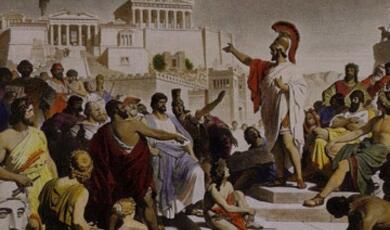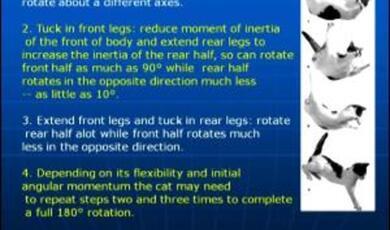The Story of Pi
Share
- Details
- Transcript
- Audio
- Downloads
- Extra Reading
The 'circle number' pi has fascinated people for thousands of years. Who first called it pi? Who had it engraved on their tombstone? Who tried to pass a law declaring it to be 3.2? How can we find pi by tossing needles? And can one square the circle?
Download Transcript
17 January 2007
The Story of pi
Professor Robin Wilson
Introduction
This lecture concerns the number pi,
π = 3.1415926535897932384626433832795028841971 …,
which is the ratio of the circumference of a circle to its diameter:
C = πd = 2πr,
(where r is the radius), and is also the area of a circle of radius 1:
A = πr2 = π12 = π.
The first few digits of π can be remembered as the number of letters in the words of the following sentences:
How I wish I could calculate pi! (3.141592)
May I have a large container of coffee? (3.1415926)
How I need a drink, alcoholic of course, after all these lectures informing Gresham audiences (3.14159265358979)
Early values
A Mesopotamian clay tablet dating from about 1800 BC claims that the ratio of the perimeter of a hexagon to the circumference of its surrounding circle is (in base-60 notation) 0;57,36. It follows that
6r / 2πr = 57/60 + 36/3600, from which it follows that π = 31/8 = 3.125, a lower estimate.
Around the same time the Egyptians found the area of a circle of diameterd to be close to that of an octagon inscribed in a square of side d: the approximation they used for the area is (d – d/9)2 = 8/9d2. In terms of the radius this area is 256/81r2, which corresponds to a value of π of about 3.16, an upper estimate.
Both of these values are better than the Biblical value given a thousand years later. In I Kings VII, 23 and II Chronicles IV, 2, we read:
Also, he made a molten sea of ten cubits from brim to brim, round in compass, and five cubits the height thereof; and a line of thirty cubits did compass it round about.
This gives a value of π = 30/10 = 3.
The polygonal method
A major advance was made by the Greeks, who attempted to estimate πby approximating the perimeter or area of a polygon by the circumferences or areas of the circles drawn inside and outside the polygon (the incircle and circumcircle).
In particular, around 250 BC Archimedes considered the perimeter of a hexagon, and then repeatedly doubled the number of sides to produce polygons with 12, 24, 48 and 96 sides. Calculating the circumferences of the incircle and circumcircle, he obtained the estimates 310/71 < π < 31/7, which yields π correctly to two decimal places.
Over the succeeding centuries mathematicians from many countries attempted to find improved values for π by successively doubling the number of sides and calculating the appropriate perimeters or areas in each case. Among the values obtained were the following:
Liu Hui (China, 250 AD): 3.1410 < π < 3.1427 (192 sides)
Zu Changzhi (China, 500 AD): 3.1415926 < π < 3.1415927 (24576 sides)
(also the approximation 355/113)
Fibonacci (Italy, 1200): π = 3.141818 (96 sides)
Al-Kashi (Samarkand, 1430): 14 decimal places
Adrian Anthoniszoon (Netherlands, 16c.) 355/113 (6 decimal places)
Francois Viète (France, 1593) 9 decimal places (393216 sides)
Adriaen van Rooman (Netherlands, 1593) 15 decimal places (230 sides)
Ludolph van Ceulen (Netherlands, 1596) 20 decimal places (60 × 229 sides)
Ludolph van Ceulen (Netherlands, 1615) 35 decimal places
New approaches
New approaches were given by Francois Viète and John Wallis, who obtained infinite expressions for π. In 1579, Viète showed that
2 / π = cos π/4 × cos π/8 × cos π/16 × cos π/32 × . . .
= ½ √2 × ½ √(2 + √2) × ½ √[2 + √(2 + √2)] × ½ √{2 + √[2 + √(2 + √2)]} × . . . .
In 1655, Wallis obtained the infinite product
2= 1 × 3 × 3 × 5 × 5 × 7 × 7 × … .
π 2 × 2 × 4 × 4 × 6 × 6 × 8 × …
Another new and highly productive approach involved the tan–1 function. If y = tan x, then x = tan–1 y; for example, tan–1 1 = π/4 and tan–1 1/√3 = π/6. The following results are among many that can be proved:
π/4 = tan–1 (1/2) + tan–1 (1/3) = 4 tan–1 (1/5) + tan–1 (1/239).
The tan–1 function can be written in series form:
tan–1 (x) = x – x3/3 + x5/5 – x7/7 + … .
Putting x = 1 gives
π/4 = 1 – 1/3 + 1/5 – 1/7 – 1/9 + …,
but this series converges exceedingly slowly. However, we can use the above identities to obtain better estimates for π: in particular, in 1706 John Machin used the last result, π/4 = 4 tan–1 (1/5) + tan–1 (1/239) (where each of these tan–1 series converges more rapidly), to calculate πto 100 decimal places. This approach was continued by others: for example, in 1874 Shanks calculated π to 707 decimal places, but it was subsequently discovered that only the first 526 of these were correct.
A probabilistic method for finding π was introduced by the Comte de Buffon in 1777, in his ‘needle experiment’. Suppose that you throw a large number of needles (or matchsticks) of length L onto a grid of parallel lines at a distance A apart, where L < A, and note the number of needles that cross a line of the grid. It can be shown that the probability that a given needle crosses a line is equal to 2L / π A, from which a value for π can be calculated.
It had long been expected that π is an irrational number – that is, it cannot be written as a fraction a/b, where a and b are whole numbers. After a long struggle this was proved by Johann Heinrich Lambert in 1767, who proved that if x is a rational number (other than 0), then tan x cannot be rational; thus, if tan x is rational, then x must be irrational or 0. Since tan π/4 = 1, which is rational, it follows that π/4, and hence π, cannot be a rational number.
In 1897 a bizarre event took place in the State of Indiana, USA, where the House of Representatives considered and unanimously passed ‘A bill introducing a new Mathematical Truth’. This attempted to legislate an incorrect value for π provided by a local physician, who would then allow the State to use the legislated value free of charge, but would expect royalties to be paid to him by anyone else who used it. The bill was passed on to the House Committee on Swamp Lands, who then passed it on to the Committee on Education. Fortunately, a local professor of mathematics happened to be visiting the court room when the bill was about to be finally ratified, and it was stopped just in time.
Enter the computer
Once desk calculators and computers entered the scene, it became possible to use various tan–1 series to calculate π to more and more decimal places, as follows:
1949 ENIAC 2037 places
1955 NORC 3089 places
1957 Pegasus 7480 places
1959 IBM (Paris) 16167 places
1961 IBM (New York) 100000 places
1966 CDC 6600 (Paris) 500000 places.
Subsequently the number of known decimal places exceeded a million, then a billion, and now stands at over a trillion.
© Professor Robin Wilson, Gresham College, 17 January 2007
This event was on Wed, 17 Jan 2007
Support Gresham
Gresham College has offered an outstanding education to the public free of charge for over 400 years. Today, Gresham plays an important role in fostering a love of learning and a greater understanding of ourselves and the world around us. Your donation will help to widen our reach and to broaden our audience, allowing more people to benefit from a high-quality education from some of the brightest minds.


 Login
Login







